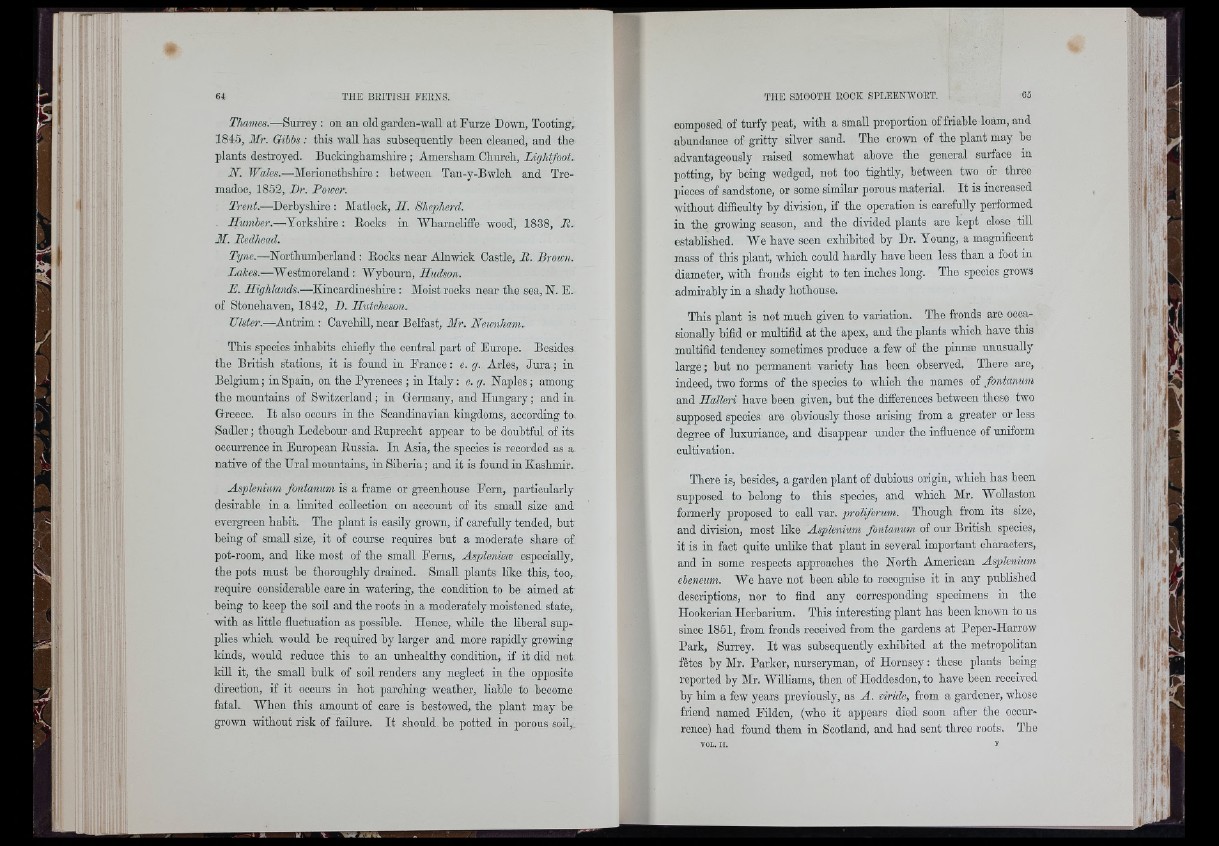
Thames.—Surrey : on an old garden-wall at Furze Down, Tooting,
1846, Mr. Gibbs : this wall has subsequently been cleaned, and the
plants destroyed. Buckinghamshire ; Amersbam Church, Lightfoot.
N. Wales.—Merionethshire : between Tan-y-Bwlob and Tremadoo,
1852, Pr. Power.
Trent.—Derbyshire : Matlock, II. Shepherd.
Humber.—^Yorkslm-e : Eocks in Wbarnobffe wood, 1838, R.
M. Redhead.
Tyne.—Northumberland : Eocks near Alnwick Castle, P . Prown.
Lakes.—Westmoreland; Wybourn, Hudson.
E. Highlands.-—Kincardineshire : Moist rooks near tbe sea, N. E.
of Stonehaven, 1842, P. Hutcheson.
Ulster.—Antrim : CavehOl, near Belfast, Mr. Newnham.
This species inhabits chiefly tbe central part of Europe. Besides
the British stations, it is found in France ; e. g. Arles, Jura ; in
Belgium ; in Spain, on tbe Pyrenees ; in Italy : e. g. Naples ; among
the mountains of Switzerland ; in Germany, and Hungary ; and in
Greece. It also occurs in tbe Scandinavian kingdoms, according to
Sadler ; though Ledebour and Euprecht appear to be doubtful of its
occurrence in European Eussia. In Asia, tbe species is recorded as a
native of tbe Ural mountains, in Siberia ; and it is found in Kashmir.
Asplenium fontanum is a frame or greenhouse Fern, particularly
desirable in a limited collection on account of its small size and
evergreen habit. The plant is easily grown, if carefully tended, but
being of small size, it of course requires but a moderate share of
pot-room, and Kke most of tbe small Ferns, Aspleniem especially,
tbe pots must be thoroughly drained. SmaU plants Kke tbis, too,
require considerable care in watering, tbe condition to be aimed at
being to keep the soU and tbe roots in a moderately moistened state,
witb as little fluctuation as possible. Hence, wbüe tbe liberal supplies
which would be required by larger and more rapidly growing
kinds, would reduce tbis to an unhealthy condition, if it did not.
kill it, tbe small bulk of soU renders any neglect in tbe opposite
direction, if it occurs in bot parching weather, liable to become
fatal. When tbis amount of care is bestowed, tbe plant may be
grown without risk of failure. It should be potted in porous soil.
composed of turfy peat, witb a small proportion of friable loam, and
abundance of gritty silver sand. Tbe crown of tbe plant may bo
advantageously raised somewhat above tbe general surface in
potting, by being wedged, not too tightly, between two dr three
jjieces of sandstone, or some similar porous material. It is increased
without difficulty by division, if tbe operation is carefuUy performed
in tbe growing season, and tbe divided plants arc kept close tOl
established. Wo have seen exhibited by Dr. Young, a magnificent
mass of tbis plant, wbiob could hardly have been less than a foot in
diameter, witb fronds eight to ten inches long. Tbe species grows
admirably in a shady hothouse.
Tbis plant is not much given to variation. The fronds are occasionally
bifid or multifid at tbe apex, and tbe plants ■which have tbis
multifid tendency sometimes produce a few of tbe pinnæ unusually
large; but no permanent variety has been observed. There are,
indeed, two forms of tbe species to wbiob tbe names of fontanum
and Halleri have been given, but tbe differences between tbese two
supposed species are ob'viously those arising from a greater or less
degree of luxuriance, and disappear under tbe influence of uniform
cultivation.
There is, besides, a garden plant of dubious origin, which has been
supposed to beloug to tbis species, and which Mr. Wollaston
formerly proposed to call var. proliferum. Though from its size,
and dmsion, most like Asplenium fontanum of our British species,
it is in fact quite unlike that plant in several important characters,
and in some respects approaches tbe North American Asplenium
ebeneum. We have not been able to recognise it in any pubHsbod
descriptions, nor to find any corresponding specimens in tbe
Hookerian Herbarium. Tbis interesting plant has been known to us
since 1851, from fronds received from the gardens at Peper-Harrow
Park, Surrey. It was subsequently exhibited at tbe metropolitan
fêtes by Mr. Parker, nurseryman, of Hornsey : those plants being
reported by Mr. WUKams, then of Hoddesdon, to have been received
by him a few years previously, as A. viride, from a gardener, whoso
friend named Filden, (who it appears died soon after the occurrence)
bad found them in Scotland, and bad sent throe roots. The
I'D -ta
l l
y i : i . ; l
: I
■ i- .
'■XI '.i
: ! ■■" I
( 1 "
i f ' . Y
'■i ' l
■I’iH
IH